Papers by Patricia Grosse Brewer
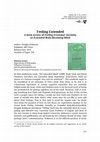
In their (in)famous work, "The Extended Mind" (1998), Andy Clark and David Chalmers introduce the... more In their (in)famous work, "The Extended Mind" (1998), Andy Clark and David Chalmers introduce the Extended Mind Hypothesis (henceforth, EMT) by means of a famous example: Otto and his notebook 61. This notebook ought to be considered as an extension of Otto's mind, they claim, as he uses it as a functional equivalent of certain cognitive capacities that are normally lodged inside the head. Clark and Chalmers have to do the hard work of laying the groundwork for getting cognition out of the head. However, EMT is missing something that Clark and Chalmers find pernicious. In fact, if this review were a proper space for joking, I would say that Clark and Chalmers do not want to include into their theory what many men do not like to even talk about: their feelings. That is, they seek to avoid the "qualia trap," by which they mean the question of how we feel about our experiences (qualia). In his recent book Feeling Extended: Sociality as Extended Body-Becoming-Mind, Douglas Robinson introduces "feeling" back into the extended mind in a compelling and effective way. Currently Chair Professor of English and Dean of the Arts Faculty at Hong Kong Baptist University, Robinson's varied research interests and publications are all found by the common thread of inter-(and perhaps intra-) communication. Robinson is in the difficult position of strad-61 I would like to thank Georg Theiner for his helpful comments and suggestions on an earlier version of this review.

Hypatia, 2016
Theories concerning love in the West tend to be bound by the problematic constraints of patriarch... more Theories concerning love in the West tend to be bound by the problematic constraints of patriarchal conceptions of what counts ontologically as “true” or “universal” love. It seems that feminist love studies must choose between shining light on these constraints or bursting through them. In this article I give a feminist analysis of Augustine of Hippo's theory of love through a philosophical, psychological, and theological reading of his complicated relationships with women. I argue that, given the “embodied” nature of his many loves throughout his life, there is room in Augustine's account of love for a gendered reading of love that is unconstrained by patriarchal notions concerning which gender is capable of which kind of love. Augustine's theory of love is one that is not coldly universal but bodied and personal; indeed, although it is founded inside patriarchal historical constructions, it is capable of bursting out of these constraints and suggesting an egalitarian,...

Hypatia
The Routledge Handbook of Love in Philosophy contains thirty-nine chapters by individual philosop... more The Routledge Handbook of Love in Philosophy contains thirty-nine chapters by individual philosophers within the field of philosophy of love. Each chapter explores some aspect of the nature or history of the philosophy of love utilizing the author's disciplinary methodology in its own way. The editor of this volume, Adrienne M. Martin, has collated this collection into seven distinct sections: I. Family and Friendship; II. Romance and Sex; III. Politics and Society; IV. Animals, Nature, and the Environment; V. Art, Faith, and Meaning; VI. Rationality and Morality; and, finally, VII. Traditions: Historical and Contemporary. Topics in this collection range from the morality of not loving one's children ("'Mama, Do You Love Me?': A Defense of Unloving Parents," by Sara Protasi) to the history of the discourse surrounding love in Islamic thought ("Love in Islamic Philosophy," by Ali Altaf Mian). Given the diversity of chapters and authors, one may find this volume useful in gaining an overview of certain conversations within the philosophy of love. The individual sections themselves may be valuable to those teaching relevant courses: for example, I used two chapters from part VII (Lenn E. Goodman's "Love in the Jewish Tradition" and Ali Altaf Mian's "Love in Islamic Philosophy") in a course titled Philosophies of Desire. These chapters provided my students with a broader understanding of love and desire than is usually provided in collections on this theme. The chapters in part VII, which focus on the place of love in various historical traditions, explore the place and history of love in traditions from Confucianism to neuroscience; these chapters could be an excellent starting point for scholars interested in historical and contemporary philosophies of love. There are few such large anthologies on the philosophy of love (or on love in philosophy) as such-most collections feature sex rather heavily, as the philosophy of sex and love is an established subdiscipline of philosophy spearheaded by the philosopher Alan Soble. Christopher Grau and Aaron Smuts have a forthcoming edited collection-The Oxford Handbook of Philosophy of Love (Grau and Smuts forthcoming)-on the same topic and in which at least one author from the text under review has published. A major difference between the Routledge and Oxford handbooks is that the Routledge handbook concerns itself in large part to rationalistic conceptions of and inquiries into the nature of love. The Oxford handbook seems to be focused more on the topic of love throughout more types of philosophical discourse (continental philosophy is well represented).

Modern popular theories of emotion distinguish between loves: there is true love and puppy love, ... more Modern popular theories of emotion distinguish between loves: there is true love and puppy love, parental love and child love, friendly, Platonic love, the love for and of our pets, the love for and of non-human others. What is often considered a different category all together are states like obsession, lust, the desire for domination, the laser focus of an abuser on their victim. These series of emotional states are set over and against love: they are false loves, they masquerade as the real thing but deep down have their origin in violence and hatred, misogyny and rage. These states provoke a common response in champions of love: they are not real love. But what if these vicious states are kinds of love? What if they come from the same place from whence the purest of loves springs? What if they are, in fact, forms of Bad Love? This chapter provides a selective philosophical history and analysis of "bad love" in several of its myriad forms. The methodology used for this analysis is gleaned from feminist theory, the history of emotions, and the moral psychology of Augustine of Hippo. There are two major sections of this essay: "When Love Was Bad," provides a brief background on the philosophical history of "bad love." Beginning with Platonic "bad love," this section swiftly turns to Augustine's analysis of love and emotion. The second major section, "Bad Love, Revisited," synthesizes Augustine's account of emotion with Susan Brison's feminist philosophical account of the effect of trauma on the psyche. The chapter concludes with a reexamination of Platonic negging and Augustinian emotion, thus reaffirming the slipperiness of Bad Love. This essay contributes to the philosophical literature on the history of the emotions as well as philosophy of love.
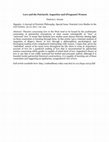
Theories concerning love in the West tend to be bound by the problematic constraints of patriarch... more Theories concerning love in the West tend to be bound by the problematic constraints of patriarchal conceptions of what counts ontologically as " true " or " universal " love. It seems that feminist love studies must choose between shining light on these constraints or bursting through them. In this article I give a feminist analysis of Augustine of Hippo's theory of love through a philosophical, psychological, and theological reading of his complicated relationships with women. I argue that, given the " embodied " nature of his many loves throughout his life, there is room in Augustine's account of love for a gendered reading of love that is unconstrained by patriarchal notions concerning which gender is capable of which kind of love. Augustine's theory of love is one that is not coldly universal but bodied and personal; indeed, although it is founded inside patriarchal historical constructions, it is capable of bursting out of these constraints and suggesting an egalitarian, nongendered view of love.
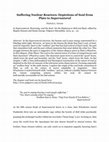
Supernatural, Humanity, and the Soul, 2014
In the Supernatural universe, the human soul is pure energy represented by a blinding white light... more In the Supernatural universe, the human soul is pure energy represented by a blinding white light. However, we learn in the Season Six finale that Sam’s soul, at least, must be tripartite: there is the “soulless” part that has had control of Sam’s body, the part that remembers hell, and the part without memories that must defeat the other two. This struggle between the parts is suggestive of the chariot allegory given in Plato’s Phaedrus. In this allegory, Plato likens “the soul to the natural union of a team of winged horses and their charioteer” (Phaedrus 246a). The charioteer must strive to control the “good” horse, which loves the good and beautiful, and the “bad” horse, which loves the body. In this chapter, I offer a clear philosophical and theological examination of the nature of soul as depicted in the first six seasons of the television series Supernatural. Focusing especially on “soulless Sam” in the sixth season, I explore the origin of the soul-body connection in Plato as well as the nature of moral culpability in Augustine. Sam Winchester is indeed himself while “soulless,” and yet, without a healthy balance between the various competing natures within his soul, he cannot be held morally accountable for his bad actions.
Conferences by Patricia Grosse Brewer
Talks by Patricia Grosse Brewer
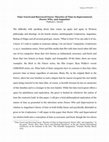
“What is time? If no one asks it of me, I know; if I wish to explain to someone asking, I do not ... more “What is time? If no one asks it of me, I know; if I wish to explain to someone asking, I do not know” (Augustine, Confessions 11.14.17, translation mine). So Augustine, Bishop of Hippo, ponders the difficulty of thinking about time. The problem of time as it relates to the individual comes up again and again in western culture, especially in pop culture. The difficulties Augustine faces and the difficulties the average science fiction writer faces come down to the difficulty of creating a meaningful account of the porosity of time. How do we talk about time when it is always flowing past us, towards us, and away from us?
In this paper, I will explore the fogginess of time as presented in the television series Doctor Who and Supernatural in relation to Augustine’s theory of time as extension as given in his Confessions. In the first section, I will give brief account of Augustine’s theory of present time as extended into the past. It will be the work of this section to establish the difficulty surrounding the nature of time with respect to eternity. In the next section, I will turn to the problem of the relationship between time and eternity in the television series Supernatural, most notably in the show’s depiction of “Hell time” as lasting longer than “Earth time” as well as in the main character’s several forays into the past and present through angelic intervention.
In the third and final section of my paper, I will analyze the presentation of “wibbly wobbly, timey wimey” (“Blink” 2007) in Doctor Who. In particular, I will discuss the newest series of Doctor Who, which involves a new Doctor, played by Peter Capaldi, with a borrowed face. In the first episode, “Deep Breath,” the newly regenerated Doctor bemoans why he could have given himself a face that could not possibly be his own: "It's covered in lines. But I didn't do the frowning. Who frowned me these lines?" (“Deep Breath” 2014). This statement is deeply troubling: The Doctor’s faces are always new and aged, but this new face is somehow different and significant to the time traveler. Also in this season The Doctor has frequently referred to his difficulty in “seeing” fixed moments in time--this difficulty caused by the importance of certain events.
Ultimately, Doctor Who’s understanding of time as both porous and impermeable and Supernatural’s account of the interrelation between time and “destiny” can be used to elucidate Augustine’s account of the difficulty of having a conception of “future time” in relation to the past, the present, or eternity--we travel through time all the time, every moment, and this traveling may lead to breaches in what is and what ought to be.
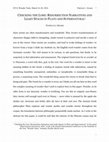
The television series Supernatural is full of marvelous transformations and horrific possibility.... more The television series Supernatural is full of marvelous transformations and horrific possibility. Now entering its eleventh season, the show is currently exploring the time before there was time, before the creation of the world. This time before history, full of danger and chaos, has been stalking the protagonists of the series for the entirety of the show--the darkness just at the outskirts of reality bleeds into the fabric of the universe and causes unreality within the matrix of the real. These spots of unreality have been the focus of the show week to week for over a decade and there is nearly always “lore,” fairy stories and mythology wound together to aid the hero (or anti-hero) in completion of his or her duty.
The Ancient Greek philosopher Plato too explores myths and fairy stories in his own way. Indeed, the entirety of the Platonic corpus may be seen as a mythological tale--the dialogues of Plato are, after all, stories about his deceased teacher Socrates. Plato weaves myths into his philosophy, the two intertwining such that the distinction between myth and philosophy becomes unclear--rather than giving an account of the meaning behind existing myths (a mytho-logos), Plato creates the myths themselves (mytho-poesis), their power unclear and likely dangerous.
In this paper I will explore the interrelation between the resurrection narratives and fantastical spaces that make up the world of Supernatural and the philosophy of Plato. The telling and retelling of these myths creates a compendium of “lore” which the series and philosopher use to explore the nature of what it is to be human, what came before, what will come to pass, and the possibility for redemption. While the lore in Supernatural seems to provide escape and safety, its representation in Plato belies the dark warnings at the heart of these wondrous tales.
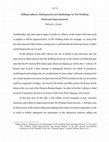
Myths and fairy tales abound in epic television. For example, the television series, Supernatural... more Myths and fairy tales abound in epic television. For example, the television series, Supernatural explores both alien and fairy abduction stories in the sixth season episode “Clap Your Hands if You Believe.” The Walking Dead has elements of the Odyssey woven into the fabric of the show. Both series explore the Oedipus myth in the relationship between fathers, sons, and mothers. When TV Series “do myths,” they are often said to be just retelling these myths. After all, the word mythology comes from the Ancient Greek words “mythos” and “logos.” “logos,” so loved by philosophers, means an account or story, so “mythology” implies a static account or interpretation of a myth. However, this is not the sole relationship epic shows like The Walking Dead and Supernatural have with myths.
Throughout his long writing career, the fifth century CE philosopher and theologian Augustine of Hippo continuously turned to the myth of Adam and Eve’s expulsion from Eden. The Yahwistic story of Adam and Eve goes as follows: God, upon seeing the loneliness of Adam, makes him a companion from his side. In exchange for a rib Adam gets a wife. Eve subsequently is deceived by a serpent, eats of the forbidden fruit from Tree of the Knowledge of Good and Evil (here depicted as a peach tree), and, seeing that it is good, gives a bite to Adam. In Book IX of Paradise Lost, John Milton writes of Adam’s motivation for eating Eve’s apple: it is his absolute love for Eve and his feeling that he could not stand to be with “another Eve” that influences his decision to eat the forbidden fruit. The story on its own neglects to say much about the nature of the first humans or of humans today. Accordingly, Augustine’s interest in this myth was not merely in this aspect of it. Rather, what Augustine sought from this original story was an understanding of what it means to be human.
In this talk I seek to examine the ways in which myths are made in epic television, specifically in TWD and Supernatural. Epic television utilizes mythological backgrounds to make the stakes feel epic--not only retelling myths but also in making them anew. I will begin this talk by outlining several examples of mythological storylines and echoes in TWD and Supernatural. I will then turn to the presence of the mythic telling and making of his echoes of myth in Augustine’s work in order to further emphasize the importance of the distinction between telling and making myths. Finally, I will I outline what I take the significance of the creation and making of myths by further examining the use of myths in TWD and Supernatural.
Mythopoesis is a better word for what the Late Antique Augustine as well as 21st century epic television are doing. Mythopoesis (mythos + poesis) implies that the myth is being made —poesis is an active word in Ancient Greek meaning to make, not just tables and chairs, but poetry as well.
There were many things I could have talked about concerning my interest in Augustine.
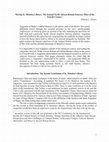
Augustine of Hippo’s mother Monnica is the patron saint of alcoholics. Her saintly affiliation co... more Augustine of Hippo’s mother Monnica is the patron saint of alcoholics. Her saintly affiliation comes through her peculiar presence in her son’s autobiography confessiones, in which he gives an account of her life, including her proclivity for both wine and a particular North African ritualistic funerary practice. Augustine himself is baffled at the end of his tale, surprised that she suddenly no longer wished to have her bones taken back to Africa to be interred alongside her husband. This paper explores the funerary practices of Late Antique Roman society in the context of this work and the ultimate placement of Monnica’s bones.
It is impossible to read Augustine outside of his historical context, and reading the constraints between North African Roman and Italian Roman culture in his works is of benefit both to Augustine philosophical and theological research as well as to classical historical studies. This paper ultimately makes the claim that the confessiones is Augustine’s monument to his mother — the monument which she declined as she was approaching death in Ostia, a port city near Rome. This monument, far from being sensually bereft, is rife with sensory, affective descriptions of what it is like to love and be loved.
Augustine devotes 14.7 of De ciu. dei to a discussion of the presence of the kinds of love accoun... more Augustine devotes 14.7 of De ciu. dei to a discussion of the presence of the kinds of love accounted for in Christian Scripture. This chapter warrants deeper consideration in the context of the relationship between reason and emotions as well as between emotions and love in Augustine’s theology and Late Antique Christianity. I will show that Augustine’s account of concupiscentia, too, is one that ought to be reconsidered, for it calls into question what one might consider “emotion” to be.
Drafts by Patricia Grosse Brewer
This paper is based on “Haraway’s Curiosity and Derrida’s Shame, the Radical Alterity of Cats,” p... more This paper is based on “Haraway’s Curiosity and Derrida’s Shame, the Radical Alterity of Cats,” plenary panel, SUNY Buffalo’s Comparative Literature Department’s Graduate Conference, “animal.machine.sovereign,” Buffalo, NY; April 2011. I use this paper in my Introduction to Ethics courses and Introduction to Philosophy courses.











Uploads
Papers by Patricia Grosse Brewer
Conferences by Patricia Grosse Brewer
Talks by Patricia Grosse Brewer
In this paper, I will explore the fogginess of time as presented in the television series Doctor Who and Supernatural in relation to Augustine’s theory of time as extension as given in his Confessions. In the first section, I will give brief account of Augustine’s theory of present time as extended into the past. It will be the work of this section to establish the difficulty surrounding the nature of time with respect to eternity. In the next section, I will turn to the problem of the relationship between time and eternity in the television series Supernatural, most notably in the show’s depiction of “Hell time” as lasting longer than “Earth time” as well as in the main character’s several forays into the past and present through angelic intervention.
In the third and final section of my paper, I will analyze the presentation of “wibbly wobbly, timey wimey” (“Blink” 2007) in Doctor Who. In particular, I will discuss the newest series of Doctor Who, which involves a new Doctor, played by Peter Capaldi, with a borrowed face. In the first episode, “Deep Breath,” the newly regenerated Doctor bemoans why he could have given himself a face that could not possibly be his own: "It's covered in lines. But I didn't do the frowning. Who frowned me these lines?" (“Deep Breath” 2014). This statement is deeply troubling: The Doctor’s faces are always new and aged, but this new face is somehow different and significant to the time traveler. Also in this season The Doctor has frequently referred to his difficulty in “seeing” fixed moments in time--this difficulty caused by the importance of certain events.
Ultimately, Doctor Who’s understanding of time as both porous and impermeable and Supernatural’s account of the interrelation between time and “destiny” can be used to elucidate Augustine’s account of the difficulty of having a conception of “future time” in relation to the past, the present, or eternity--we travel through time all the time, every moment, and this traveling may lead to breaches in what is and what ought to be.
The Ancient Greek philosopher Plato too explores myths and fairy stories in his own way. Indeed, the entirety of the Platonic corpus may be seen as a mythological tale--the dialogues of Plato are, after all, stories about his deceased teacher Socrates. Plato weaves myths into his philosophy, the two intertwining such that the distinction between myth and philosophy becomes unclear--rather than giving an account of the meaning behind existing myths (a mytho-logos), Plato creates the myths themselves (mytho-poesis), their power unclear and likely dangerous.
In this paper I will explore the interrelation between the resurrection narratives and fantastical spaces that make up the world of Supernatural and the philosophy of Plato. The telling and retelling of these myths creates a compendium of “lore” which the series and philosopher use to explore the nature of what it is to be human, what came before, what will come to pass, and the possibility for redemption. While the lore in Supernatural seems to provide escape and safety, its representation in Plato belies the dark warnings at the heart of these wondrous tales.
Throughout his long writing career, the fifth century CE philosopher and theologian Augustine of Hippo continuously turned to the myth of Adam and Eve’s expulsion from Eden. The Yahwistic story of Adam and Eve goes as follows: God, upon seeing the loneliness of Adam, makes him a companion from his side. In exchange for a rib Adam gets a wife. Eve subsequently is deceived by a serpent, eats of the forbidden fruit from Tree of the Knowledge of Good and Evil (here depicted as a peach tree), and, seeing that it is good, gives a bite to Adam. In Book IX of Paradise Lost, John Milton writes of Adam’s motivation for eating Eve’s apple: it is his absolute love for Eve and his feeling that he could not stand to be with “another Eve” that influences his decision to eat the forbidden fruit. The story on its own neglects to say much about the nature of the first humans or of humans today. Accordingly, Augustine’s interest in this myth was not merely in this aspect of it. Rather, what Augustine sought from this original story was an understanding of what it means to be human.
In this talk I seek to examine the ways in which myths are made in epic television, specifically in TWD and Supernatural. Epic television utilizes mythological backgrounds to make the stakes feel epic--not only retelling myths but also in making them anew. I will begin this talk by outlining several examples of mythological storylines and echoes in TWD and Supernatural. I will then turn to the presence of the mythic telling and making of his echoes of myth in Augustine’s work in order to further emphasize the importance of the distinction between telling and making myths. Finally, I will I outline what I take the significance of the creation and making of myths by further examining the use of myths in TWD and Supernatural.
Mythopoesis is a better word for what the Late Antique Augustine as well as 21st century epic television are doing. Mythopoesis (mythos + poesis) implies that the myth is being made —poesis is an active word in Ancient Greek meaning to make, not just tables and chairs, but poetry as well.
It is impossible to read Augustine outside of his historical context, and reading the constraints between North African Roman and Italian Roman culture in his works is of benefit both to Augustine philosophical and theological research as well as to classical historical studies. This paper ultimately makes the claim that the confessiones is Augustine’s monument to his mother — the monument which she declined as she was approaching death in Ostia, a port city near Rome. This monument, far from being sensually bereft, is rife with sensory, affective descriptions of what it is like to love and be loved.
Drafts by Patricia Grosse Brewer
In this paper, I will explore the fogginess of time as presented in the television series Doctor Who and Supernatural in relation to Augustine’s theory of time as extension as given in his Confessions. In the first section, I will give brief account of Augustine’s theory of present time as extended into the past. It will be the work of this section to establish the difficulty surrounding the nature of time with respect to eternity. In the next section, I will turn to the problem of the relationship between time and eternity in the television series Supernatural, most notably in the show’s depiction of “Hell time” as lasting longer than “Earth time” as well as in the main character’s several forays into the past and present through angelic intervention.
In the third and final section of my paper, I will analyze the presentation of “wibbly wobbly, timey wimey” (“Blink” 2007) in Doctor Who. In particular, I will discuss the newest series of Doctor Who, which involves a new Doctor, played by Peter Capaldi, with a borrowed face. In the first episode, “Deep Breath,” the newly regenerated Doctor bemoans why he could have given himself a face that could not possibly be his own: "It's covered in lines. But I didn't do the frowning. Who frowned me these lines?" (“Deep Breath” 2014). This statement is deeply troubling: The Doctor’s faces are always new and aged, but this new face is somehow different and significant to the time traveler. Also in this season The Doctor has frequently referred to his difficulty in “seeing” fixed moments in time--this difficulty caused by the importance of certain events.
Ultimately, Doctor Who’s understanding of time as both porous and impermeable and Supernatural’s account of the interrelation between time and “destiny” can be used to elucidate Augustine’s account of the difficulty of having a conception of “future time” in relation to the past, the present, or eternity--we travel through time all the time, every moment, and this traveling may lead to breaches in what is and what ought to be.
The Ancient Greek philosopher Plato too explores myths and fairy stories in his own way. Indeed, the entirety of the Platonic corpus may be seen as a mythological tale--the dialogues of Plato are, after all, stories about his deceased teacher Socrates. Plato weaves myths into his philosophy, the two intertwining such that the distinction between myth and philosophy becomes unclear--rather than giving an account of the meaning behind existing myths (a mytho-logos), Plato creates the myths themselves (mytho-poesis), their power unclear and likely dangerous.
In this paper I will explore the interrelation between the resurrection narratives and fantastical spaces that make up the world of Supernatural and the philosophy of Plato. The telling and retelling of these myths creates a compendium of “lore” which the series and philosopher use to explore the nature of what it is to be human, what came before, what will come to pass, and the possibility for redemption. While the lore in Supernatural seems to provide escape and safety, its representation in Plato belies the dark warnings at the heart of these wondrous tales.
Throughout his long writing career, the fifth century CE philosopher and theologian Augustine of Hippo continuously turned to the myth of Adam and Eve’s expulsion from Eden. The Yahwistic story of Adam and Eve goes as follows: God, upon seeing the loneliness of Adam, makes him a companion from his side. In exchange for a rib Adam gets a wife. Eve subsequently is deceived by a serpent, eats of the forbidden fruit from Tree of the Knowledge of Good and Evil (here depicted as a peach tree), and, seeing that it is good, gives a bite to Adam. In Book IX of Paradise Lost, John Milton writes of Adam’s motivation for eating Eve’s apple: it is his absolute love for Eve and his feeling that he could not stand to be with “another Eve” that influences his decision to eat the forbidden fruit. The story on its own neglects to say much about the nature of the first humans or of humans today. Accordingly, Augustine’s interest in this myth was not merely in this aspect of it. Rather, what Augustine sought from this original story was an understanding of what it means to be human.
In this talk I seek to examine the ways in which myths are made in epic television, specifically in TWD and Supernatural. Epic television utilizes mythological backgrounds to make the stakes feel epic--not only retelling myths but also in making them anew. I will begin this talk by outlining several examples of mythological storylines and echoes in TWD and Supernatural. I will then turn to the presence of the mythic telling and making of his echoes of myth in Augustine’s work in order to further emphasize the importance of the distinction between telling and making myths. Finally, I will I outline what I take the significance of the creation and making of myths by further examining the use of myths in TWD and Supernatural.
Mythopoesis is a better word for what the Late Antique Augustine as well as 21st century epic television are doing. Mythopoesis (mythos + poesis) implies that the myth is being made —poesis is an active word in Ancient Greek meaning to make, not just tables and chairs, but poetry as well.
It is impossible to read Augustine outside of his historical context, and reading the constraints between North African Roman and Italian Roman culture in his works is of benefit both to Augustine philosophical and theological research as well as to classical historical studies. This paper ultimately makes the claim that the confessiones is Augustine’s monument to his mother — the monument which she declined as she was approaching death in Ostia, a port city near Rome. This monument, far from being sensually bereft, is rife with sensory, affective descriptions of what it is like to love and be loved.